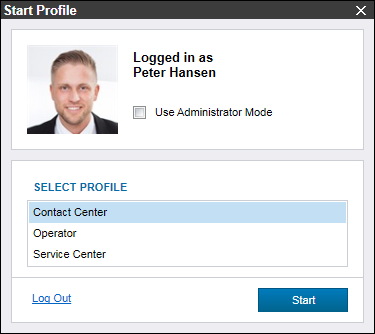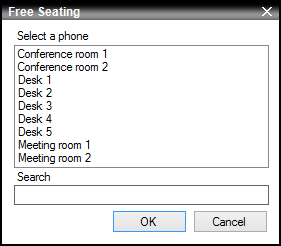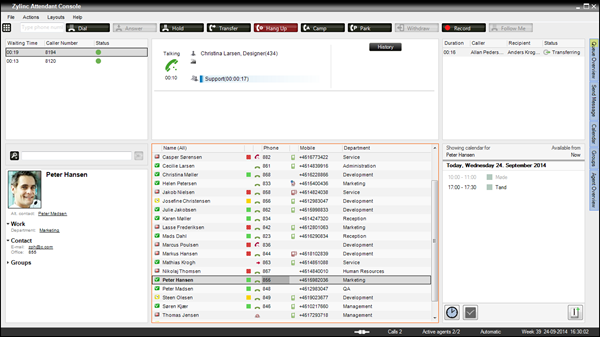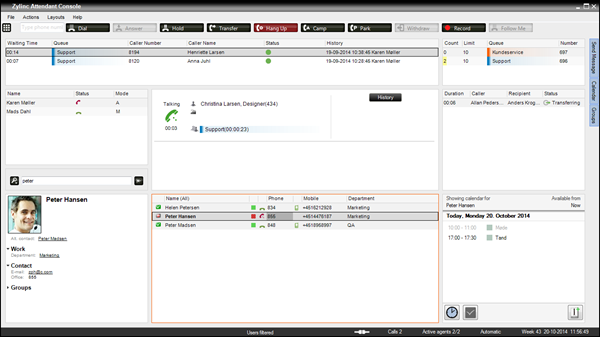To get started, all you need to do is to launch your Zylinc desktop program and log in to it.
If you have more than one Zylinc program, the Start Profile window may appear after you've logged in. If so, select the program that you want to use and click Start.

If you have administrator rights, you can select Use Administrator Mode in the top of the Start Profile window. Only log in as administrator when you want to change other users' program settings, and remember to log out when you're done. In general operation, don't use administrator mode, because changes you make in administrator mode may propagate to other users' profiles.
When the program has loaded, you may be presented with the Free Seating option.
With free seating you can select between different phones, so you don't need to sit by the same phone every time.
If your organization uses free seating, your Zylinc solution will ask you to select which phone you want to use. If the list is long, use the selection window's search field to easily find the phone that you want.

If you don't want to use free seating, simply click Cancel.
Zylinc desktop programs consist of a number of overviews that each display different content, such as calls, calendar details, people details, etc. The overviews complement each other, and many of the overviews are interlinked, so that if you select something in one overview, the content of other overviews update to reflect your selection.
You can place, drag, resize, and even hide overviews to suit your needs. For this reason, we'll focus on overviews' features and content, not on their position.
The overviews are where you usually interact with the program, but there's also a menu at the top of the window, and a status bar at the bottom. The status bar can, for example, display the number of inquiries that wait to be answered.
Furthermore, you may see a dock strip in the left, right, or bottom part of the window. A dock strip lets you open overviews that aren't permanently displayed; it's thus ideal for overviews that you don't want to view all of the time.

 Dock strip
Dock strip
This is a list of overviews that most people use in their Zylinc programs. There are several other overviews that aren't listed here, because they depend on exactly which type of job you do with your Zylinc program.
|
The View people, resources, and availability gives you an overview of people and other resources, for example meeting rooms or queues, as well as information about their status. |
|
|
|
In the View user details overview you can view categorized, detailed information about someone you've selected in the Time overview. |
|
|
|
The View calendar details overview displays a list of calendar appointments for someone you've selected in the Time overview. |
|
|
|
In Change calendar settings you can select which days you want to view in the Time overview and in the Calendar details overview. |
|
|
|
Use Search to find a specific person or resource. You can search for most of the available information, including names, e-mail addresses, and phone numbers. |
|
|
|
In the Select and manage groups overview you select and manage groups. A group is a set of users. For example, a group can represent all people in a department, or people with special responsibilities or skills. |
|
|
All Zylinc desktop programs have a top menu called Layouts in which you can select an overall layout for your program that best suits the way that you work.
The difference between layouts is typically:
-
which overviews are shown permanently
-
which are shown in dock strips
-
how the overviews are positioned relative to each other


Two slightly different layouts
You can change the size of overviews if you drag their edges. Your changes will be saved as part of the selected layout. If you regret your changes, you can reset the layout if you select Layouts > Restore to default Layouts.
This is help for Zylinc version 6.0. To view Zylinc unified help for other versions, go here.
© 2021 Zylinc A/S • Disclaimer
Help version: 22 January 2021 13:21:22
Share this topic:





